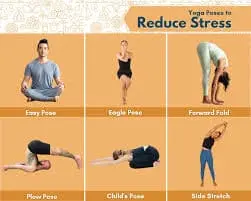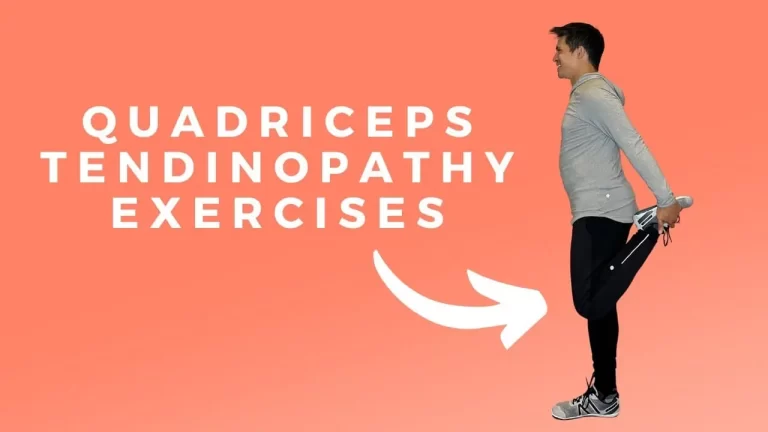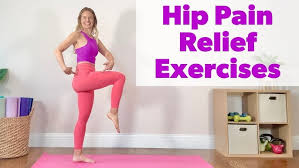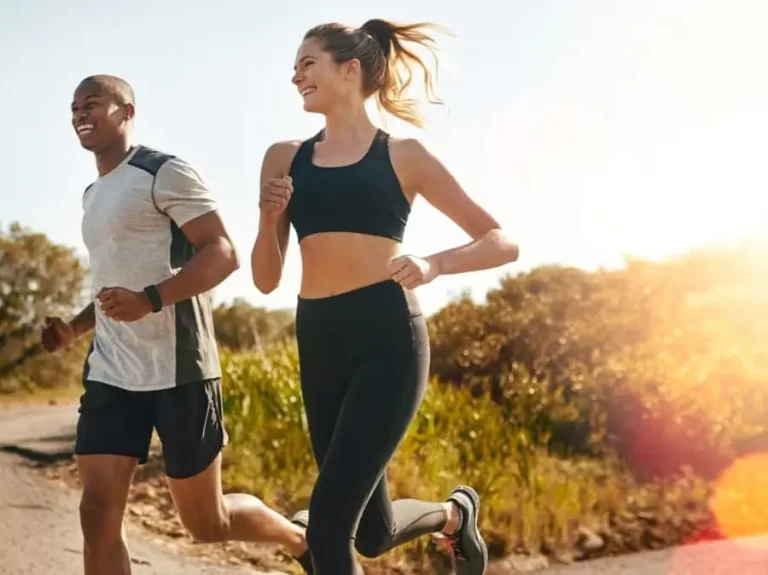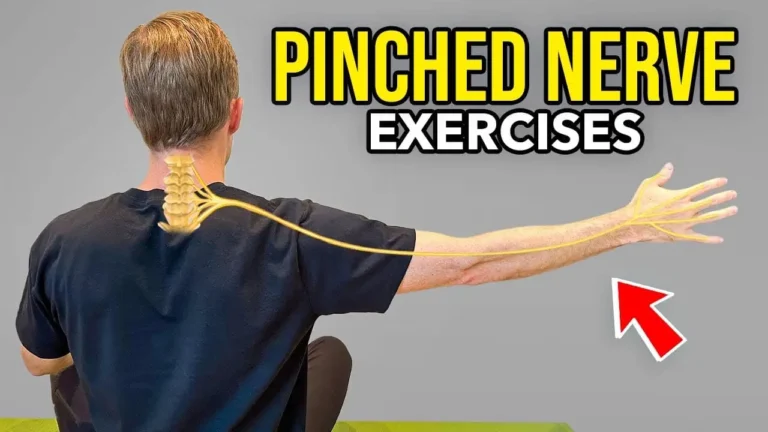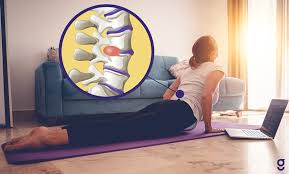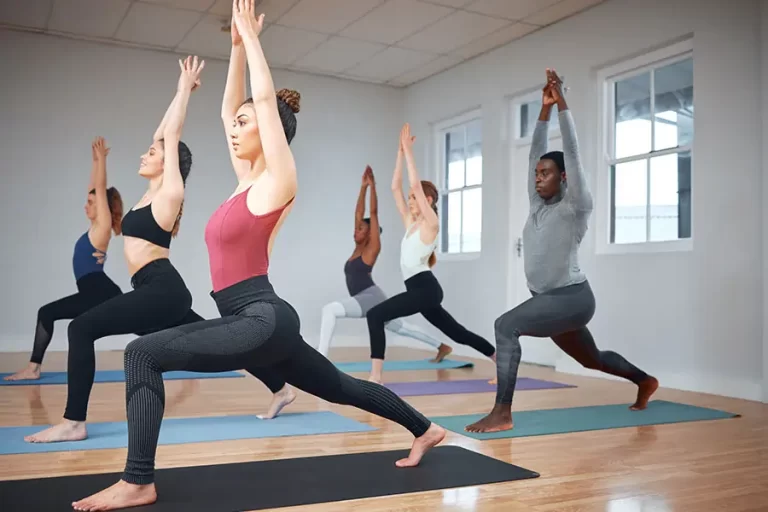14 Best Yoga To Relieved Stress
Stress has become common in the modern world. Whether stress is caused by personal struggles, pressure from the workplace, or a general sense of overburden, it can have an unhealthy impact on one’s physical and mental health. One of the best ways to manage stress is through yoga, a traditional method that promotes meditation, balance, and relaxation.
This article will discuss Yoga To Relieve Stress, its benefits for stress management, and advice for beginning a yoga practice.
Introduction:
For most people, stress happens every day. Finding strategies to reduce stress and prevent it from entering your life is important because it can be moderate in certain situations and severe in others. One way to reduce stress is to practice yoga.
Yoga’s popularity keeps rising as more individuals discover its mental and physical advantages. A frequent goal for those who want to encourage good growth and concentrate on self-improvement is to prevent and minimize stress, which can be achieved by starting a personal yoga practice.
You may be able to release stress and emotions by doing yoga positions that help you reduce physical limitations like muscular knots. Additionally, they encourage the release of feel-good hormones called endorphins, which can improve your ability to cope with stress.
During your yoga practice, concentrating on the here and now helps you become more aware, concentrate better, and focus your thoughts.
The Benefits of Yoga for Stress Reduction:
- Encourages Prolonged Relaxation
The parasympathetic nerve system, sometimes known as the “rest and digest” system, is activated when yoga helps the body achieve a deep level of relaxation. Yoga creates a relaxing effect that lowers blood pressure, and heart rate, and promotes calmness by focusing on the breath and employing slow, purposeful movements.
- Reduces Tension in the Muscles
Muscle tension is a common sign of stress, especially in the shoulders, neck, and back. Asanas, or specific postures, are used in yoga to help people stretch and relieve this tension. Stress-related pain can be instantly relieved by releasing tense muscles with the help of gentle yoga poses.
- Improves Focus and Mental Clarity
Stress may affect decision-making, making it difficult to concentrate or think clearly. By helping practitioners concentrate on the present movement, yoga promotes attention. Movement, peace, and breath awareness all contribute to mental relaxation, which promotes mental clarity. This mental focus not only helps during practice but also improves concentration and decision-making in daily life, which makes managing challenging situations easier.
- Promotes Oxygen Flow and Breathing
The focus on deep breathing, or pranayama, is one of the fundamental elements of yoga. The body receives more oxygen while breathing slowly and constantly, which lowers stress chemicals like cortisol and promotes the relaxation response. By expanding lung capacity and raising blood oxygen levels, breathing techniques like diaphragmatic breathing and alternative nostril breathing might help the body better handle stress and anxiety.
- Lowers Anxiety and Encourages Emotional Stability
One of the most prevalent side effects of stress is anxiety, which yoga effectively reduces. Yoga’s focused technique helps control the neurological system, which lowers anxiety levels. The mind can be calmed by some positions, particularly those that incorporate forward bends and gentle twists. Additionally, the meditation aspect of yoga helps practitioners manage powerful emotions like worry, fear, or frustration by promoting emotional balance and concentration.
- Improves Sleep Quality
A good night’s sleep is frequently affected by stress and anxiety. By reducing physical stress that may be affecting relaxation and beneficial to the neurological system, yoga helps improve sleep quality. To prepare the body and mind for a good night’s sleep poses like Savasana (Corpse Pose) and Legs Up the Wall (Viparita Karani) are very beneficial. Regular yoga practice can help you sleep better and longer, which will give you more energy and help you handle stress better.
- Gives a sense of control
Feeling out of control or overcome by outside events is a common cause of stress. By concentrating on your body, breath, and mind, yoga offers the chance to regain control. As you continue to practice, you will feel more in control of your breathing and posture patterns, which can help you feel more in control of how you react to stress. This feeling of strength can help you feel less powerless and improve your ability to handle stress healthily.
- Improves General Happiness and Well-Being
Endorphins are the body’s natural “feel-good” hormones, and yoga increases their production. As a result, one’s mood and sense of well-being improve. Including yoga in your daily routine can help you feel more calm, less angry or depressed, and have a more positive outlook on life. Increased strength and flexibility are two physical advantages that also support improved body awareness and self-worth.
- Develops Present-Moment Awareness and Concentration
A basic principle of yoga is the practice of awareness, which involves staying fully engaged and present in the moment. You can avoid the worrying habit that often follows stressful situations by using this strategy. Instead of thinking about the past or the future, yoga encourages you to focus on your breath, your environment, and the sensations in your body. Because of this improved awareness, you may face life with greater strength and calm, which also helps in better stress management.
- Improves the Relationship Between Mind and Body
A strong bond between the body and mind is promoted by yoga. Yoga helps you become more self-aware by concentrating on how your body feels in each pose and paying attention to your thoughts and feelings as they come up. It may be simple to identify when stress is increasing and take protective measures to reduce it if there is a greater mind-body connection. This relationship also promotes self-compassion, which allows you to handle stressful situations with greater tolerance and understanding.
The Best Yoga Poses for Stress Relief:
Certain yoga poses are very beneficial for promoting relaxation and reducing stress. These poses promote mental calmness, tension release, and physical opening.
Some useful yoga poses to include in your practice are as follows:
Child’s Pose (Balasana)
Child’s Pose is a very calming pose that relaxes the nervous system and extends the thighs, hips, and back. It’s an excellent way to start or finish your practice.
- Start by placing your wrists just beneath your shoulders and your knees about hip-width apart on a tabletop position.
- Depending on how comfortable you are, slowly sit your hips back toward your heels while maintaining your knees together or widely apart.
- To stretch your spine, reach forward and extend your arms in front of you on the floor, palms down.
- For a more relaxing variation, you can also place your arms next to your body with the palms facing up.
- Let your neck relax and place your forehead gently on the floor.
- For extra comfort, place a block or cushion beneath your forehead.
- As you hold the pose for a few breaths, concentrate on relaxing your mind and letting go of any tension in your body.
- Allow your body to relax even farther into the stretch as you exhale, and feel your ribcage expand as you inhale.
- Then return to your neutral position.
- Then relax.
- Repeat this yoga pose for 5 to 10 times.
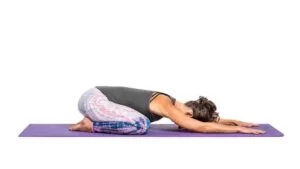
Cat-Cow Pose (Marjaryasana-Bitilasana)
Tension in the neck, shoulders, and spine can be released with this gentle movement between two positions. The change from rounding to arching the back also promotes deep breathing.
- Start on your hands and knees, placing your knees beneath your hips and your wrists exactly beneath your shoulders.
- To support your weight, keep your fingers wide apart.
- Raise your chest and tailbone toward the ceiling while arching your back during the inhalation.
- Allow your abdomen to fall toward the floor while you look forward or slightly upward, causing your spine to gently curve. It’s called the Cow Pose.
- Pull your belly button toward your spine and tuck your tailbone as you exhale, extending your spine upward.
- Imagine a cat stretching its back as you lower your head toward the floor (without bringing your chin to your chest). The cat pose is this one.
- Continue to move with your breath as you alternate between these two postures.
- To enter Cow Pose, take a breath; to enter Cat Pose, take a breath out.
- For multiple rounds, repeat the action while keeping your breath in rhythm.
- Then return to your neutral position.
- Then relax.
- Repeat this yoga pose for 5 to 10 times.
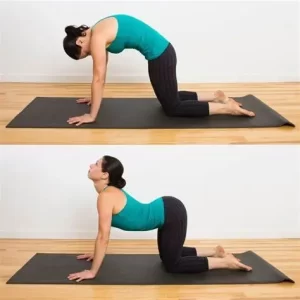
Legs Up the Wall (Viparita Karani)
This healing posture encourages circulation, lowers anxiety, and relaxes the nervous system. It’s particularly beneficial for mental relaxation following a tired day.
- Look for an open area that has a wall.
- Make sure you’re near the wall when you set a blanket or yoga mat on the floor.
- Your right or left hip should be near the wall as you sit sideways.
- After that, lift your legs to the wall and slowly drop your back to the floor.
- Your thighs should be parallel to the wall and your feet contracted as you extend your legs straight up against the wall.
- To ensure that your legs are supported comfortably, adjust the distance between you and the wall.
- To increase your level of relaxation, you can raise your hips a little by placing a pillow or block underneath them.
- You can rest your arms on your tummy if you’d like, or you can rest them out to the sides with your palms facing up.
- With your neck in a neutral posture and your head comfortably resting on the floor, you can make your neck more comfortable by placing a folded towel or small pillow beneath your head.
- Close your eyes and concentrate on your breathing, taking deep breaths in and out.
- For a few seconds, or longer if it feels good, relax yourself into the pose.
- Gently turn to one side, bend your knees slowly, and pull them toward your chest before raising yourself back up to a seated posture.
- Then return to your neutral position.
- Then relax.
- Repeat this yoga pose for 5 to 10 times.
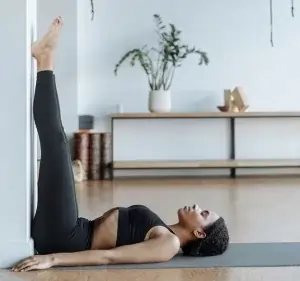
Standing Forward Bend (Uttanasana)
Back, shoulder, and neck tension is released in this pose.
- Place your arms at your sides, keep your body tall and straight, and place your feet hip-width apart.
- When you inhale deeply, extend your arms upwards and lengthen your spine.
- Bend slowly forward from your hips (not your waist) as you release the breath, maintaining a small bend in your knees if necessary.
- As you tilt at the hips, try to move your upper body closer to your thighs while maintaining a long spine.
- Let your head hang loosely after folding your body up.
- Any neck tightness can be relieved by giving it a gentle shake.
- Depending on your level of flexibility, place your hands on the ground, your ankles, or your shins.
- If your hands aren’t touching the floor, you can use yoga blocks underneath them to make the pose easier to do.
- Pay attention to your deep breathing and let your upper body droop.
- Over time, you can gradually increase the stretch’s depth by straightening your legs more (without locking your knees).
- Breathe deeply and relax into the stretch while you hold this pose for a few seconds, or whatever long it feels comfortable.
- Then return to your neutral position.
- Then relax.
- Repeat this yoga pose for 5 to 10 times.
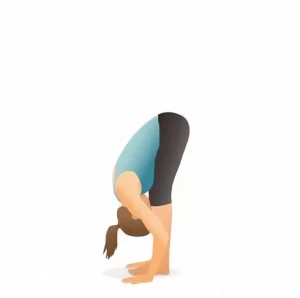
Seated Forward Fold (Paschimottanasana)
This pose stretches the hamstrings, lower back, and spine while promoting relaxation and stress relief.
- Your legs should be straight out in front of you while you sit on the floor.
- Maintain a flexed foot position, with the toes pointing up at the sky, and a straight but loose knee.
- Lengthen your spine as you take a deep breath, reaching your head’s top toward the ceiling.
- Imagine that when you get ready to fold, your spine gets taller.
- With your back as extended as you can, begin to bend forward over your legs as you exhale, progressively leaning at the hips rather than the waist.
- Avoid going back too soon.
- Instead, concentrate on hip-based movement.
- Your flexibility will depend on whether you extend your hands to your shins, ankles, or feet.
- Hold onto your feet with your hands if you can reach them.
- If you are unable to reach your feet, place your hands on your legs or secure yourself with a yoga strap around your foot soles.
- Your head should be relaxed about your legs.
- Release any tightness in your neck to keep it long and prevent straining.
- Try to let go of any tension in your body and extend the stretch as you take deep breaths.
- Your body will eventually approach your thighs, but it’s important to concentrate on lengthening rather than pushing the fold.
- Hold this position for a few seconds.
- Then return to your neutral position.
- Then relax.
- Repeat this yoga pose for 5 to 10 times.
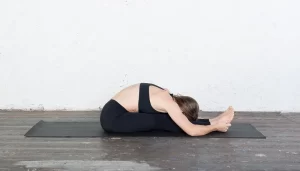
Easy Pose (Sukhasana)
Easy Pose, also known as Sukhasana, is a straightforward pose that releases mental tension and anxiety in both beginning and intermediate yoga.
- Sit on the floor with your legs out in front of you to start.
- For support, you can use a cushion or a yoga mat.
- One foot should rest in front of the other as you cross your legs and bend your knees.
- Your knees should slowly go under toward the floor, and the soles of your feet should be facing up.
- Make sure that the bones you sit on, known as your sit bones, are securely connected to the ground.
- Maintaining a straight spine will be easier if you sit on a cushion, blanket, or bolster to raise your hips a little if they are tight.
- Maintain a long spine and sit upright.
- To keep your neck in line with your spine, imagine something pulling the top of your head toward the ceiling.
- Palms facing either upward or downward, depending on your preference, place your hands on your knees or thighs.
- To expand up your chest and make space between your shoulder blades, gently rotate your shoulders back and down.
- If it is comfortable for you, close your eyes and start breathing deeply and mindfully.
- Breathe in and out slowly through your nose to focus on the present moment and now.
- Sukhasana can be held for a few minutes or more, based on what you prefer.
- It’s perfect for focusing on yourself, deep breathing, and meditation.
- Then return to your neutral position.
- Then relax.
- Repeat this yoga pose for 5 to 10 times.
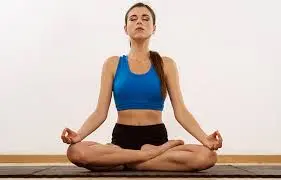
Eagle Pose (Garudasana)
Eagle position, also known as Garudasana, is a complex position that helps in stress relief and concentration by letting you “squeeze” out physical tension and concentrate on your balance.
- Place your arms at your sides and stand tall with your feet hip-width apart.
- Breathe deeply a few times to help you focus on yourself.
- Put your weight on your left leg and start by bending your knees slightly.
- You’ll stand on this leg.
- With your right foot outside your left calf, raise your right leg and cross it over your left, or wrap it over your left thigh or calf if you can.
- You don’t want to put your foot on your knee.
- Finding balance while maintaining a squared hip position and an active core is the primary goal here.
- Lift your arms shoulder-high and straight out in front of you.
- Then, with your elbows bent at a right angle, cross your right arm beneath your left arm, pulling your palms together, or as near as possible.
- Put the backs of your hands together if you are unable to move your palms together.
- To help you stay balanced, pull your belly button closer to your spine.
- To help keep your stability, keep your chest up and your eyes on a spot in front of you.
- Maintaining a long spine, lower your hips and bend your knees further into a squat.
- Your legs will stretch more deeply as a result, and your balance will be tested.
- Hold this position for a few seconds.
- Relax your arms and legs gradually before standing up again.
- Then return to your neutral position.
- Then relax.
- Repeat this yoga pose for 5 to 10 times.
- Repeat the position on the other side after taking a little break.
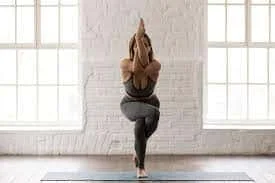
Half Shoulder Stand (Sarvangasana)
As your legs are elevated over your heart, this pose improves your mood and quality of sleep while also improving your body’s circulation.
- On a yoga mat, start by lying on your back with your legs straight and your arms at your sides.
- Press the soles of your feet against the mat while bringing your legs together.
- For support, place your hands flat on the floor next to your body.
- Using your core, raise your legs straight up toward the ceiling while you take a breath.
- Make sure your legs are parallel to the ground.
- Without resting on your neck, use your core strength to gently raise your hips off the floor.
- With your elbows close to the floor, support yourself by placing your hands on your lower back after raising your hips.
- Maintain a straight body alignment from your shoulders to your toes while in this position.
- Your neck shouldn’t be compressed; it should stay long.
- The weight should be supported by your shoulders and upper arms rather than your neck.
- Keep your head from tilting or rotating, and make sure the back of it rests comfortably on the floor.
- You can stay balanced by keeping your gaze fixed on the ceiling.
- Hold this pose for a few seconds.
- Return your legs to the floor carefully when you’re ready to exit the stance.
- Then return to your neutral position.
- Then relax.
- Repeat this yoga pose for 5 to 10 times.
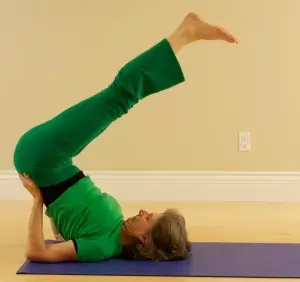
Bridge Pose (Setu Bandha Sarvangasana)
The heart is elevated above the head in Bridge Pose, also known as Setu Bandha Sarvangasana, which functions as a mild inversion. It relaxes the brain and central nervous system, reduces tension and anxiety, and lessens moderate depression.
- Lay flat on your back on a yoga mat to begin.
- Maintain a hip-width distance between your feet and knees, with your knees bent.
- The palms of your arms should be down at your sides.
- Make sure the soles of your feet are firmly pressed into the mat and that your feet are clearly beneath your knees.
- Your hips and knees ought to line up.
- As you start using your legs and core, press your feet into the mat.
- Lift your hips toward the ceiling by using your thigh and glute muscles.
- Start by slowly raising your hips off the floor, vertebra by vertebra, so that your shoulders and knees form a straight line.
- Maintain a grounded head and shoulders on the mat.
- For extra stability, press your arms into the floor and, if you feel comfortable, connect your fingers beneath your back.
- Additionally, it deepens the bend in the back and expands the chest.
- Maintain a neutral, relaxed neck posture and refrain from turning your head.
- Make sure your chin rests just a little bit on your chest.
- Hold this position for a few seconds.
- Then return to your neutral position.
- Then relax.
- Repeat this yoga pose for 5 to 10 times.
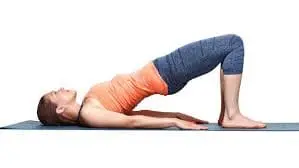
Tree Pose (Vrikshasana)
Encourages focus and concentration: The balancing technique in this position helps to relax the mind and lower stress levels by promoting mental focus and awareness.
- With both feet together and your weight equally split between them, take a tall stance.
- Maintain a straight back while using your legs and core.
- Let your shoulders drop.
- Using the sole of your foot as a basis, gradually shift your weight to your left leg.
- Maintain a small bend in your left knee while keeping it in line with your toes.
- Place the sole of your right foot on your left leg’s inner thigh, calf, or ankle after raising it off the ground.
- Stay wary of putting it directly on the knee as this may apply unnecessary pressure.
- Your balance will be more difficult the higher you put your foot (on the thigh).
- Gather your palms in front of your chest in the Anjali Mudra, or prayer pose, after you’ve regained your balance.
- You can also maintain your arms by your sides or raise them aloft with your palms facing each other.
- To keep your balance, look at a drishti, or point, in front of you.
- Continue to breathe mindfully and slowly while maintaining an even focus.
- Hold this pose for a few seconds.
- Then return to your neutral position.
- Then relax.
- Repeat this yoga pose for 5 to 10 times.
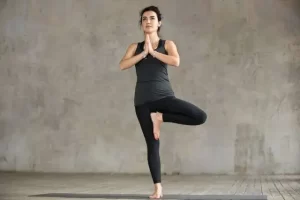
Reclining Bound Angle Pose (Supta Baddha Konasana)
Hip and lower back stiffness can be released with this mild hip opener. It’s a relaxing pose that encourages deep relaxation as well.
- Sit on the floor with your legs out in front of you to start.
- Move your feet close to your pelvis while bending your knees so that their soles make contact.
- Open up your hips by letting your knees drop lightly toward the floor.
- If your knees aren’t comfortable reaching the floor, you can support them with pillows or blocks.
- Either lay your arms by your sides or on your belly with your hands down or extend them out to the sides with your palms facing up.
- Being comfortable and relaxed in this position is the aim.
- Your chin should be slightly tucked in as you gently place your head on the floor, keeping it in line with your spine.
- Breathe slowly and deeply while maintaining the stance, filling your nostrils with air and letting it out completely through your lips.
- Let your body relax and let go of any stress with each inhalation.
- Then return to your neutral position.
- Then relax.
- Repeat this yoga pose for 5 to 10 times.
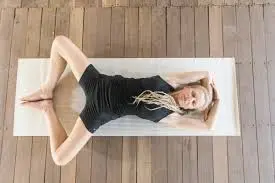
Stick Pose (Yastikasana)
Yastikasana, or Stick practice, is a straightforward and energetic yoga practice that strengthens and expands the body. It helps to activate the muscles in your arms, legs, and core and is excellent for increasing flexibility, particularly in the shoulders and spine. This pose is frequently used to help the body relax or warm up.
- With your legs straight out in front of you, take a seat on the floor. Maintain a straight spine, relaxed shoulders, and flexed feet.
- Maintaining both arms parallel to one another, raise them both toward the ceiling.
- To lengthen through your arms and chest, engage your arms and spread your fingers wide.
- Exhale through the top of your head and extend your back as you do so.
- Do not sag or curve your back; instead, keep your body engaged.
- Continue raising your arms as you exhale, maintaining the length of your spine.
- Press your heels into the floor to keep your legs moving, and make sure your legs are firm and straight.
- Hold this pose for a few seconds concentrating on lengthening your body and keeping your arms, body, and legs stretched.
- Continue to look directly ahead or slightly up.
- Exhale and slowly move your arms back to your sides to release the pose, letting your body relax.
- Then return to your neutral position.
- Then relax.
- Repeat this yoga pose for 5 to 10 times.
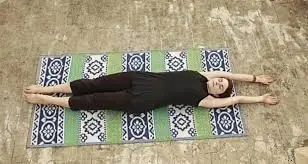
Happy Baby Pose (Ananda Balasana)
The calming and fun yoga practice known as “Happy Baby Pose” (Ananda Balasana) works the thighs, hips, and lower back. It is an excellent way to relax the mind, stretch the inner thighs, and release stress.
- To begin, lay on your mat with your feet flat on the ground and your knees bent.
- Hold the outsides of your feet with your hands while pulling your knees to your chest.
- Reach out and grasp the soles of your feet.
- Make sure your feet are exactly above your hips and your knees are bent at a 90-degree angle.
- Put your ankles over your knees.
- Pull your feet gently down toward the floor, making sure they are either slightly wider or in line with your knees.
- The soles of your feet should ideally be facing the ceiling.
- Your inner thighs need to feel stretched.
- Make sure your shoulders are relaxed and your head stays on the mat.
- Do not strain your neck or raise your head.
- Breathe deeply while you maintain the pose, letting your body relax and let go of any stress.
- Lengthen your spine with each breath in and deepen the stretch with each exhale.
- Hold this pose for a few seconds.
- Lower your knees back to your chest and gently release your feet to exit the pose.
- After that, return your legs to the floor gradually.
- Then return to your neutral position.
- Then relax.
- Repeat this yoga pose for 5 to 10 times.
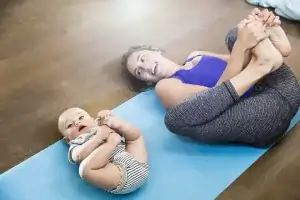
Corpse Pose (Savasana)
The ultimate relaxation pose, Savasana, is frequently performed at the end of a yoga practice. It encourages deep relaxation and allows the body to benefit from the exercise.
- Lay flat on your back on a yoga mat to begin.
- With your feet hip-width apart, maintain a comfortable and stretched pose.
- Let your toes drop to the sides as they naturally will.
- With your palms facing up, place your arms by your sides.
- Place your hands lightly on the mat and let your shoulders drop.
- Make sure that your head and heels are in a straight line.
- Ensure that your neck, spine, and head are all in a neutral posture.
- To keep your neck in alignment, tuck your chin gently toward your chest.
- Close your eyes and relax your muscles in your face.
- Breathe slowly and deeply.
- With each exhale, let your body relax as you breathe in through your nose and out through it.
- Take your attention back to your breathing softly if your thoughts go away.
- Release any tension in your body intentionally as you relax in the posture, beginning with your toes and working your way up.
- On the mat, let your body feel grounded and weighty.
- Hold this position for a few seconds.
- Give up all outside distractions and concentrate solely on your breathing and the present moment and now.
- As you prepare to exit Savasana, begin by taking a deeper breath.
- Stretch your arms and legs, start moving your fingers and toes gently, and then slowly roll to one side.
- Push yourself up to a seated position using your hands.
- Then return to your neutral position.
- Then relax.
- Repeat this yoga pose for 5 to 10 times.
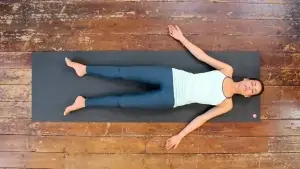
Advice for Beginning a Yoga Practice:
- Start Slow: If you’ve never done yoga before, start with short classes (10–20 minutes) and work your way up to longer ones as you get more comfortable.
- Make a Goal: Spend a moment developing an intention for your practice before you begin. This could be as straightforward as “I will focus on my breathing” or “I will let go of stress.”
- Pay attention to your body. Moving in a way that feels nice and paying attention to your body are key components of yoga. Adjust or remove a stance if it makes you uncomfortable.
- Breathe deeply: One of the most important aspects of yoga is breathing. To encourage your body’s relaxation reaction, concentrate on taking deep, constant breaths.
- Practice Frequently: For best stress relief, target to include yoga in your routine multiple times a week. Its effects build over time.
- Think About Guided Yoga: If you’re not sure where to begin, think about taking an online or in-person beginning yoga class. Proper alignment and breathing methods can be learned through guided sessions.
Safety precautions to take when performing yoga poses to relieve stress:
Even while yoga is generally risk-free and good for lowering stress, there are some precautions you should take to make sure your practice is safe and injury-free. Being aware of your body and its limitations is important, regardless of your level of experience with yoga.
The following safety precautions should be taken when doing yoga to reduce stress:
- Pay Attention to Your Body
Since every person’s physique is unique, yoga is a personal practice. Observe your body’s signals and refrain from forcing yourself into painful or uncomfortable poses. Never stretch yourself to the point of pain, just till you feel a slight pull or stretch. Adjust or remove a posture if it doesn’t seem comfortable. Yoga should be about finding balance, not about forcing your body into uncomfortable poses.
- Make sure you properly warm-up
Spend some time warming up your body before attempting more difficult poses. To get your muscles and joints ready for the practice, start with some light stretches and motions. A good warm-up can lower the chance of injury, improve flexibility, and promote blood flow.
- Don’t Overstretch
Overstretching can result in ligament damage or muscle strains, even though yoga can gradually increase flexibility. Pay attention to your range of motion, particularly if you haven’t been practicing much or are a beginner. Breathe deeply and maintain the pose gently once you feel the stretch. To avoid straining your muscles, never jump or leap during a stretch. Muscles should be stretched and lengthened gradually rather than being forced into uncomfortable positions.
- Remain within the bounds of your strength and flexibility.
It’s important to practice within your existing strength and flexibility levels if you’re new to yoga. Even trying to attempt more difficult poses before developing the necessary strength and flexibility can result in injury. As your strength and flexibility increase, progressively go on to increasingly difficult poses from beginner-friendly ones. With time, your body will adjust, allowing you to safely expand your positions.
- When necessary, take breaks.
Although yoga is supposed to be beneficial and calming, if you ever feel exhausted or dizzy, stop. You can improve your technique and avoid injuries if you respect your body’s limitations and don’t feel pressured to keep going until you’re tired.
- Drink plenty of water.
Drink plenty of water before, during, and after your yoga practice, particularly if you’re doing a more difficult form. Even while stress-relieving yoga doesn’t have to be strenuous, staying hydrated helps avoid dehydration, which can cause feelings of dizziness or exhaustion. Keep a bottle of water close at hand and drink from it as needed.
- Take a deep, concentrated breath.
An essential component of yoga is breathing. Throughout your practice, it’s important to pay attention to your breathing to guarantee enough oxygen to your tissues and to help relax your nervous system. Avoid holding your breath too much during poses since this might lead to tension and anxiety. To help relieve tension in the body while restoring consciousness to the present, instead, concentrate on taking deep, thoughtful breaths (inhale through the nose and exhale through the mouth).
- Make Use of Proper Alignment
In yoga, alignment is essential for both injury prevention and maximizing the benefits of each position. Additionally, proper alignment lessens unnecessary load on your muscles and joints. In every position, pay attention to keeping your spine neutral, your weight distributed evenly, and your core muscles active.
- Avoid Using Hard Surfaces for Practice
To avoid damage and give your body some comfort, yoga should be performed on a soft, non-slip surface, such as a yoga mat. Particularly in positions when you’re on your knees or reclining on your back, hard surfaces like tile or concrete can be uncomfortable and raise your risk of injury. With the comfort and stability that a good yoga mat offers, you can practice safely and non-slip.
- Be mindful and focused.
Even though yoga is a great way to reduce stress, it’s important to maintain present-moment awareness and concentration. Stay away from distractions such as looking at your phone or planning out future duties. To maximize the stress-relieving effects of yoga and develop a deeper connection with the mind-body experience, allow yourself to fully engage with the practice.
When should you stop practicing stress-relieving yoga poses?
It’s important to understand when to stop doing yoga poses for stress relief to maintain a healthy and productive practice. Even though yoga is typically a gentle practice, being aware of what your body requires and knowing when to stop or take a break are important.
The following are indicators that your yoga practice has to be modified or stopped:
- You Feel Pain or Uncomfortable
Pain is your body’s obvious way of telling you that something is wrong. Stop right away and adjust your position or relax if you feel sudden, intense pain or soreness while performing a pose. It’s normal to stretch until you feel uncomfortable, but never force yourself to endure severe or acute pain. There should never be any harm from yoga.
- You Experience Lightheadedness or Dizziness
Low blood sugar, poor breathing, and dehydration can all cause dizziness or lightheadedness. Stop and sit or lie down in a resting pose, such as Savasana or Child’s Pose, if you begin to feel lightheaded. Until you feel secure again, pay attention to your breathing and take deep, slow breaths.
- Your breathing is becoming short.
Yoga promotes focused breathing, but if you have dyspnea or other breathing difficulties while practicing, stop right once. This may indicate that you’re performing a position incorrectly, breathing too slowly, or exerting yourself excessively. Take a moment to relax, take a big breath, and consider whether you are exerting yourself excessively.
- You’re feeling worn out or exhausted.
Your body needs rest if you begin to feel very stressed out or exhausted during your practice. The goal of yoga for stress treatment is relaxation, so if you’re feeling exhausted or overburdened, stop practicing or end your session early. Let your body rest and recover in a comfortable position.
- Your stomach is giving you nausea or pain.
Certain yoga poses, particularly those that compress the abdomen, can occasionally cause nausea or stomach pain. Stop the practice and concentrate on your breathing if this occurs. You might want to wait a moment before practicing if you just finished a large meal. If you experience feelings of pain in your abdomen, stay away from poses that require deep twists or forward folds.
- Your joints hurt or give you aches.
If you have joint pain, particularly in your shoulders, wrists, or knees, stop practicing and evaluate your alignment. If your alignment is off or you’re forcing yourself into a pose that’s not good for your body, joint pain may result. Change your position, use help from props, or take a break in this situation.
- You Feel Hyperactive or Exhausted Mentally
Although the purpose of yoga is to promote mental calmness, you may occasionally feel overstimulated or mentally overwhelmed, particularly after a more intense practice. If that happens, pause and spend a few minutes in a pose that promotes rest. Calm your mind, be mindful, and pay attention to your breathing. Stress should be lessened, not increased, by yoga.
- You Have Any Pre-Existing Medical Conditions or Injuries
You must be aware of any limitations or safety measures that apply if you have any pre-existing injuries or medical issues. If you feel any pain or irritation in a region that has already been injured, you should stop. See an experienced yoga instructor or medical expert for modifications that fit your particular situation.
- You’re Feeling Uncomfortable On an emotional level.
Since yoga promotes relaxation and self-reconnection, it can occasionally generate strong emotions. Take a break if you feel emotionally uncomfortable, such as overwhelmed or nervous. Sometimes an approach or deep breathing can help release bottled-up emotions. Don’t be scared to pause, lie down, and allow yourself to process your feelings in these situations.
Summary:
Yoga is an effective stress-reduction approach that has mental and physical advantages. You may lessen stress, clear your head, and feel better overall by including focused movement, breathwork, and relaxation in your daily routine. Regular yoga practice can improve your ability to manage stress and lead a more balanced, relaxed life, whatever your level of experience.
Yoga has many advantages for reducing stress, including promoting physical and mental relaxation. Through a combination of physical postures, breathing exercises, and meditation, yoga provides a powerful and entirety approach to stress reduction. Whether you’re struggling with daily worries or more severe anxiety, yoga can help you relax, regain your balance, and improve your mental clarity. Incorporating yoga into your everyday practice will improve your general well-being and reduce stress.
Develop a regular practice, start with a few easy positions, and experience how yoga can improve your stress levels.
FAQ:
In what ways does yoga help in stress reduction?
Yoga combines concentration, breath control, and physical exercise to help people feel less stressed. While deep breathing (pranayama) relaxes the nervous system, physical postures (asanas) alleviate the stress that has been developed in the body. By encouraging attention to the present movement, meditation, and awareness methods help people feel less anxious and think less negatively. When combined, these components activate the body’s relaxation response, which lowers stress and improves emotional health.
Can I do yoga if I’m not very flexible or a beginner?
In fact! No matter your level of flexibility or expertise, yoga is for you. Yoga is a fantastic method to gradually improve your flexibility. You may adjust a lot of positions that are easy for beginners to fit your needs. Begin carefully, pay attention to your body, and advance progressively as your strength and flexibility increase. Additionally, there are a lot of services that provide beginner advice, like online courses or local beginner sessions.
How frequently should I do yoga to help me deal with stress?
Try to do yoga at least two or three times a week for the best stress reduction. Stress reduction and relaxation can be achieved in as little as 20 minutes. Make an effort to include yoga in your daily practice since regularity is essential. If you’ve never done yoga before, you can begin with shorter sessions and work your way up to longer ones as you get more comfortable.
Which basic yoga positions can help reduce stress?
Balasana, also known as Child’s Pose, is a calming pose that helps to extend the back.
Adho Mukha Svanasana, or downward-facing dog, is a full-body stretch that relieves tension.
The Cat-Cow Pose (Marjaryasana-Bitilasana) is a calming flow that eases tension in the back and neck.
A relaxing stretch for the hamstrings and spine is the seated forward fold (Paschimottanasana).
The ultimate relaxation stance for calming the body and mind is Savasana, also known as the corpse pose.
Is meditation required when doing yoga to reduce stress?
Even though meditation is a great way to reduce stress, it’s not required for every yoga pose. However, adding meditation or awareness to your workouts can greatly increase the advantages of stress relief. Before or after your yoga session, you can spend a few minutes meditating, concentrating on your breathing, or using a relaxing mantra. Stress can be decreased by just paying attention to your breathing during the exercise.
Can anxiety be reduced with yoga?
Yes, yoga is an effective way to manage anxiety. Through careful motion and breathwork (pranayama), yoga helps the body’s relaxation response be activated, which counteracts the stress reaction associated with anxiety that is connected with a state of flight. Pose techniques that promote calmness and peace include a Child’s Pose, Forward Folds, and gentle twists. Deep breathing techniques, such as diaphragmatic or alternate nostril breathing, can be particularly useful in lowering anxiety.
How long does it take to experience yoga’s stress-reduction benefits?
After a yoga practice, you can feel the advantages right away. After only 20 to 30 minutes of yoga, many people say they feel more at Through careful motion and breathwork (pranayama), yoga helps the body’s relaxation response be activated, which counteracts the stress reaction associated with anxiety that is connected with a state of flight. And relaxed. However, regular practice is necessary to provide long-term stress alleviation. Regular yoga practice eventually lowers stress levels overall, increases resilience to stress, and improves mental clarity.
Does doing yoga to relieve stress require any particular equipment?
No particular equipment is required to perform yoga, especially if you want to reduce stress. But it helps to have a yoga mat for support and comfort. Additionally, you can alter or improve poses with the use of props like blocks, blankets, or pillows. Wear loose-fitting, comfy clothes that don’t restrict your range of motion.
Can yoga help with stress-related sleep issues?
Yoga may improve the quality of your sleep, particularly if stress or anxiety is keeping you from getting a good night’s sleep. Legs Up the Wall and Savasana are two calming poses that help ease physical stress and relax the mind, both of which can improve sleep quality. Your body and mind can be ready for a better night’s sleep by doing yoga in the evening, particularly poses that encourage deep breathing and relaxation.
Is it possible to combine yoga with other methods of stress relief?
Sure! Other stress-relieving methods like breathing exercises, careful motion and breath work (pranayama), and yoga help the body’s relaxation response be activated, which counteracts the stress reaction associated with anxiety that is connected with a state of flight., meditation, and even physical activities like swimming or walking can be included with yoga as a complimentary practice. You may handle stress in your life in a well-rounded way by combining several stress-reduction techniques.
Does yoga provide a good stress-reduction substitute for counseling or medicine?
Yoga may be a useful technique for stress management, but it shouldn’t be used in place of counseling or medicine, particularly for people with more severe mental health conditions or chronic stress. Although yoga can help with relaxation and emotional balance, it’s best to speak with a healthcare professional for a more thorough approach if you’re dealing with serious mental health issues.
How can I maintain my motivation to do yoga regularly to relieve stress?
It can be difficult to maintain your motivation to do yoga daily, but here are some suggestions:
Create a routine: To develop consistency, do yoga at the same time every day.
Begin carefully: Yoga can be helpful and keep you motivated for even ten to fifteen minutes.
Participate in a course: Taking a yoga class, whether in person or online, can help you stay accountable.
Monitor your progress: To keep yourself motivated, acknowledge minor victories like increased flexibility or less tension.
Show self-compassion by keeping in mind that yoga is a personal practice and that perfection is not necessary. Simply show up and try your hardest.
Is it possible to practice yoga at home to reduce stress?
Of course! Yoga may be done at home with barely any supplies and space. A yoga mat and a peaceful setting are all you need.
Do I need to see a doctor before beginning yoga?
Before beginning any new physical activity, including yoga, it’s a good idea to consult your healthcare professional if you have any pre-existing medical concerns, or injuries, or are new to exercising.
References:
- Here’s How to Use Yoga for Stress Reduction. (2021, May 4). Healthline. https://www.healthline.com/health/fitness/yoga-for-stress
- Simonds, B. November 7, 2024. Seven calming yoga poses to reduce stress. Private Palladium. https://www.palladiumprivate.com/blog/7-stress-relieving-yoga-poses/
- The Art of Life. November 8, 2023. The Best 15 Yoga Pose Ideas for Stress Reduction: How to Unwind with Them. Living Art (United States). Yoga poses for stress relief: https://www.artofliving.org/us-en/stress/relief
- M. S. Admin (2024, March 7). Yoga for Stress Reduction: A Contemporary Approach to Today’s Stressors in 2024. India needs to wake up. The article https://mywakeup.in/blogs/posts/yoga-for-stress-relief-a-modern-solution-to-modern-stressors-in-2024?srsltid=AfmBOopMj8bBE7Bwbih8zR5_u6zRLOuH8X2U5pmu0a40FVXhKsYDn4I-1
- The Effects of Yoga on the Mind and Body: The Science of Calm. Oct. 12, 2023. medicine of lifestyle. The impact of yoga on the body and brain to alleviate stress is explained in https://longevity.stanford.edu/lifestyle/2023/10/03/.
- Try these nine yoga positions to relieve tension. (undated). Nike.com. This article discusses how yoga poses stress.
- Image 5, Yoga Ashrams Arhanta, n.d. seated forward bend, also known as Arhanta Yoga’s Paschimottanasana. The posture known as “seated-forward-bend-paschimottanasana” can be found.
- Image 6, You can lower your blood pressure using sukhasana. (n.d.) Easy stance. The blog at https://www.arogyayogaschool.com. Your blood pressure can be lowered with sukhasana: https://www.arogyayogaschool.com/blog/
- Image 8, get benefit to performing Shoulder-Stand https://discover.hubpages.com/health.
- Image 12, https://www.thehealthsite.com/fitness/yastikasana-use-this-asana-p314-130213/ to reduce stress after work

